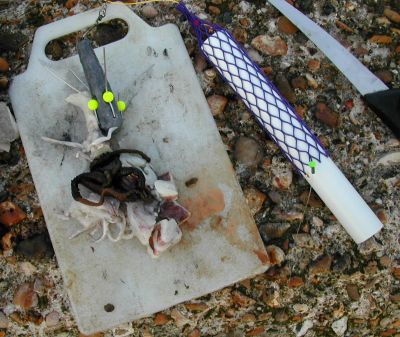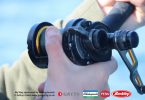I don’t think many UK sea anglers will argue if you say that it is becoming more and more difficult to catch decent fish from our waters these days, so anything designed to help is going to be looked upon as a blessing!
The Fatal Attractor is, to all intents and purposes, a ‘swimfeeder’ designed for sea fishing. Just like a coarse fishing swimfeeder, it can be used with a closed or open end i.e. you can keep the bait in it and allow it to escape gradually (or be nipped at by fish), or you can rig it up so that the bait is released in one load.
 I should point out that the Fatal Attractor is designed primarily for use on boats and piers. However, this shouldn’t exclude you from using it from the beach, which is what I did….
I should point out that the Fatal Attractor is designed primarily for use on boats and piers. However, this shouldn’t exclude you from using it from the beach, which is what I did….
The first time you use the Fatal Attractor, it may seem a bit finicky, but it’s not too bad once you get the hang of it. Basically, you need two stop beads located on your line. You secure one end of the mesh to this with a cable tie (supplied) and insert one of the plastic tubes (see picture). This cause the mesh to expand and enables you to place your bait into the tube to facilitate easy filling. I was using squid and lug, chopping the squid into small pieces before adding it.
Once you’ve placed enough ‘groundbait’ into the tube, you insert the other tube (with the blocked end) into the first and release the bait from the tube into the mesh. I was pleasantly surprised at how neat it all looked once it was done.
Now, you have two choices – do you want the bait to stay in and be released, or do you want it to come out in one go? For it to stay in for slow release, you use another cable tie and away you go. I found that, by using a tough bait such as squid, I could use the same ‘load’ for a few casts, especially as I was fishing in whiting city and the bait wasn’t in the water for a great length of time!
If you want to release your bait in one load, then you’ll need to tie up the loose end with PVA string, instead of a cable tie. In all honesty, I found this tricky on the beach, especially as my hands were wet from the bait and the bait itself was oozing liquid at a rate of knots. It is probably quite a bit easier on a boat or pier, though, and I would advise using quite a thick PVA string.

Inserting the second tube

The bait inside the Fatal Attractor
Casting was my main worry, but after seeing the Fatal Attractor ‘in action’, it shouldn’t have been. Sure, if you’re fishing a venue where distance is everything, then any addition to your rig is going to be unwelcome, but many places don’t require that you attempt to hit France with every cast and the Fatal Attractor should only shave a short distance from your cast.
The million dollar question – will it catch you more fish? As I stated above, I was fishing on an evening when whiting were abundant, so it’s very hard to form any conclusions on that basis. However, common sense tells you that a big fat juicy wedge of groundbait near your hook can only help. I’m quite excited about the thought of using it next year for bass! You do have to remember, though, that not every knock on the rodtip is a bite. It could well be fish attacking the groundbait.
The Fatal Attractor could open up a few possibilities for the angler prepared to experiment. Its basic elements are not ‘hi-tech’ when you break them down – some mesh, cable ties and a couple of plastic tubes – but the thought that has gone into it from the developer is clearly evident. Sea angling doesn’t lend itself to finesse most of the time, so an item that was robust and simple to use was required. Once you’ve used the Fatal Attractor once, you’ll realise that it fulfils both of these criteria.
The Fatal Attractor kits are priced between £5.65 and £5.95, so they won’t break the bank.
Give it a go…it may just give you the edge you need!
Tight lines,
Elton Murphy
November, 2002








